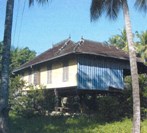

back to traditional wooden houses
Phteah Pét
Outstanding
pét houses (with roof tiles, carved wood paneling, and various architectural features) were rare for the period over which the inventory was done in the three surveyed provinces: only two houses out of 22 were identified as pé t houses. This contrasts sharply with the overwhelming proportion of pét houses that were built from the 1950s throughout the country [Delvert, 1961, 189] It is impossible to determine whether such a high pro-portion existed as well before the 1950s.
The term, meaning ‘oblique,’ refers io the hipped roof. The origin of the pét
house i s discussed elsewhere in the book. The current occupants iden-tified
their own dwellings as 'pét' Both pét houses inventoried consisted of two
buildings built one after the other, with the main one being pet-style and the
kitchen at the back. In both cases, the pét structure contained reception and
sleeping areas; a verandah, in one case, and a porch, in the other, had been
built in front to enhance the owner’s status. For the pét house in Wat Kor,
Battambang province, carpenters used a similar technique to build walls as the
one for the keung house mentioned earlier: a bamboo lattice covered with
a lime mortar, mimicking the colonial-buildings style (middle) between rooms
were placed in the main part to give some privacy to the occupants. In contrast
to other houses of similar standing, ornamentation was kept to a minimum, with
just a kâmput maetr, placed on roof ridge ends and a balustrade in the verandah
On the contrary the pét house in Kampong Cham Partitions province displayed lots
of ornamental features, notably gilded wooden carvings placed on the door lintel
in the central partition inside the house, European classic-style capitals
placed on top of columns, and other decorative elements like ceramics
brought from Vietnam. A particular feature of this house is the set of finely
carved stone bases on which the wooden posts rest (above). In both cases, as the
current occupants were keen to admit, the carpenters achieved high-quality
work,which is demonstrated by the limited maintenance carried out on the
building. According to information gathered in the research, the house in Wat
Kor was built by a commander who later became a lawyer for the French colonial
administration He was also a big landholder, owning 20 hectares of the
surrounding area. The original owner of the pét house in Prek Changkran Leu was
a trader who sold rice in Saigon and brought back all kinds of goods to the
villagers upon his return.
1950s.
The term, meaning ‘oblique,’ refers io the hipped roof. The origin of the pét
house i s discussed elsewhere in the book. The current occupants iden-tified
their own dwellings as 'pét' Both pét houses inventoried consisted of two
buildings built one after the other, with the main one being pet-style and the
kitchen at the back. In both cases, the pét structure contained reception and
sleeping areas; a verandah, in one case, and a porch, in the other, had been
built in front to enhance the owner’s status. For the pét house in Wat Kor,
Battambang province, carpenters used a similar technique to build walls as the
one for the keung house mentioned earlier: a bamboo lattice covered with
a lime mortar, mimicking the colonial-buildings style (middle) between rooms
were placed in the main part to give some privacy to the occupants. In contrast
to other houses of similar standing, ornamentation was kept to a minimum, with
just a kâmput maetr, placed on roof ridge ends and a balustrade in the verandah
On the contrary the pét house in Kampong Cham Partitions province displayed lots
of ornamental features, notably gilded wooden carvings placed on the door lintel
in the central partition inside the house, European classic-style capitals
placed on top of columns, and other decorative elements like ceramics
brought from Vietnam. A particular feature of this house is the set of finely
carved stone bases on which the wooden posts rest (above). In both cases, as the
current occupants were keen to admit, the carpenters achieved high-quality
work,which is demonstrated by the limited maintenance carried out on the
building. According to information gathered in the research, the house in Wat
Kor was built by a commander who later became a lawyer for the French colonial
administration He was also a big landholder, owning 20 hectares of the
surrounding area. The original owner of the pét house in Prek Changkran Leu was
a trader who sold rice in Saigon and brought back all kinds of goods to the
villagers upon his return.
[content from "Wooden Architecture of Cambodia", www.khmerstudies.org]
Detail drawings made by DIL SE: